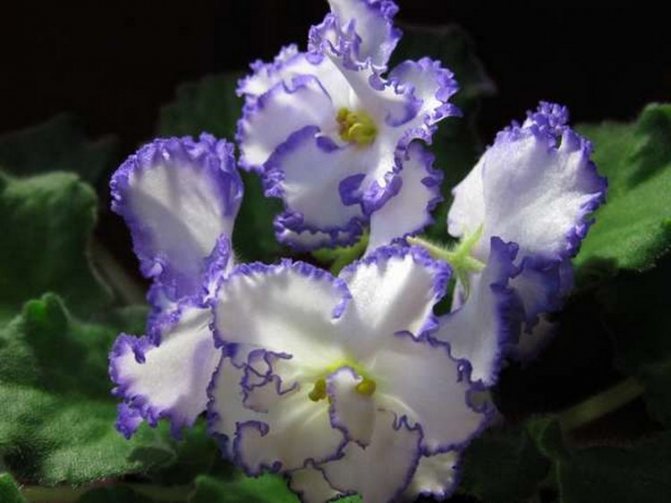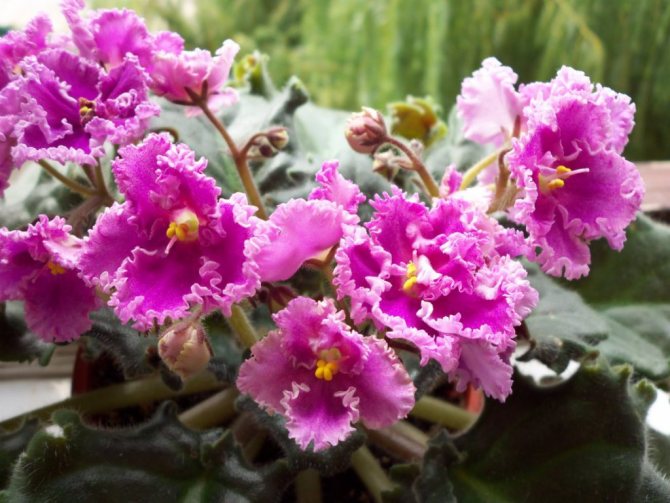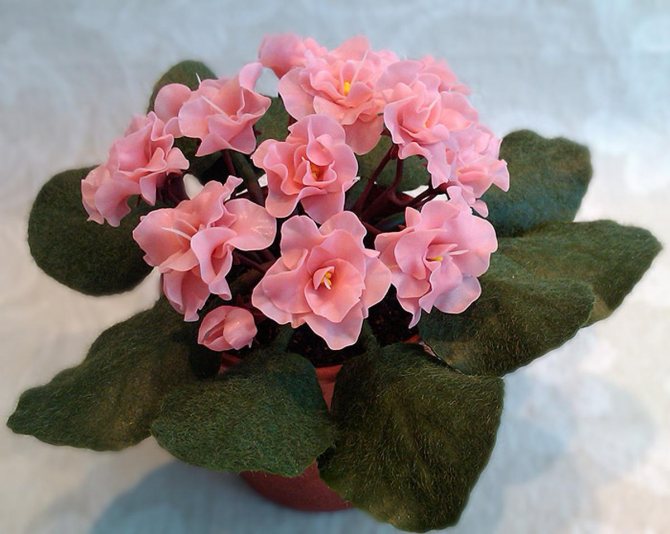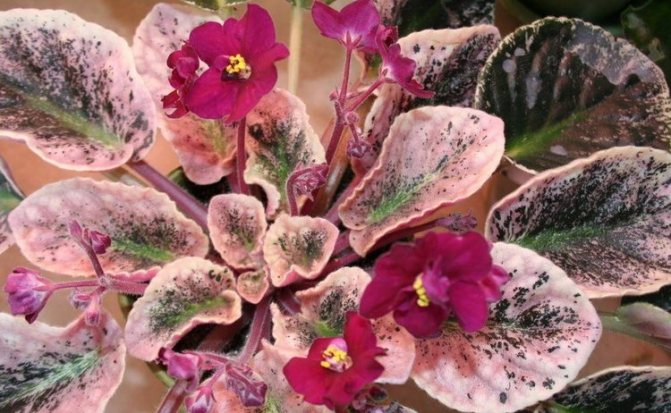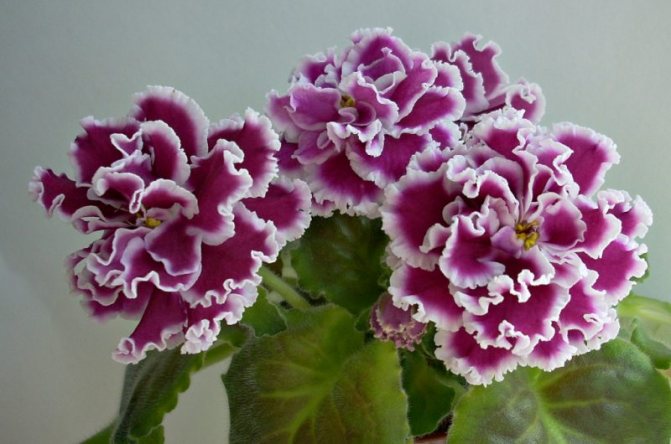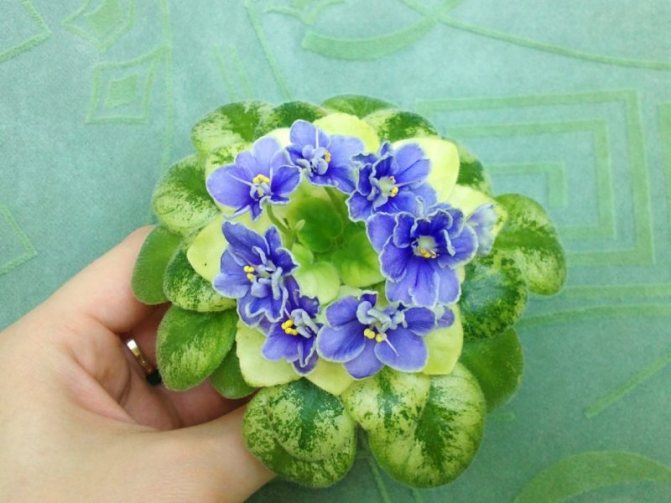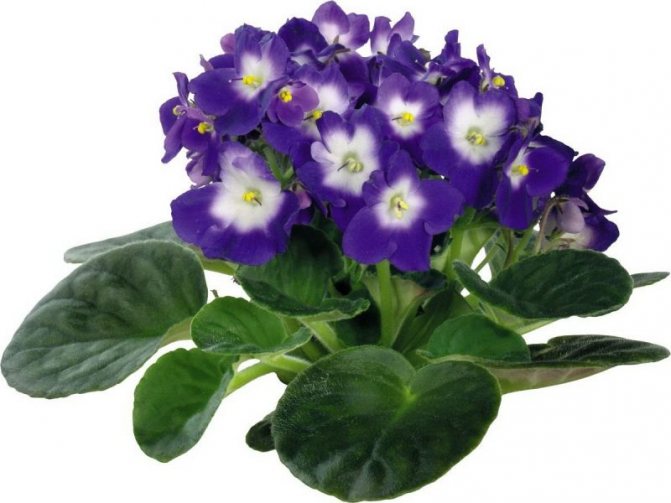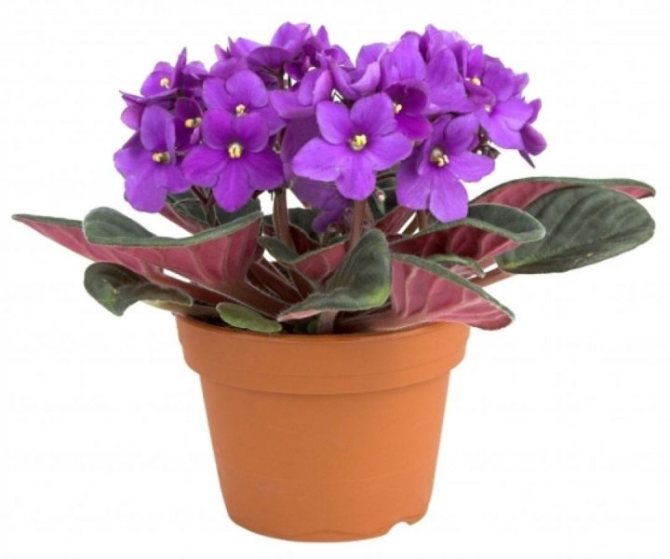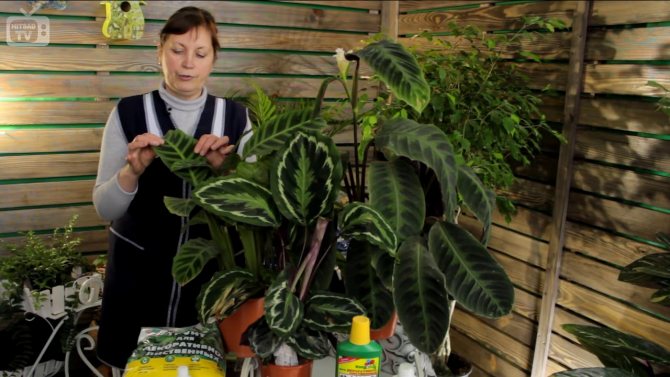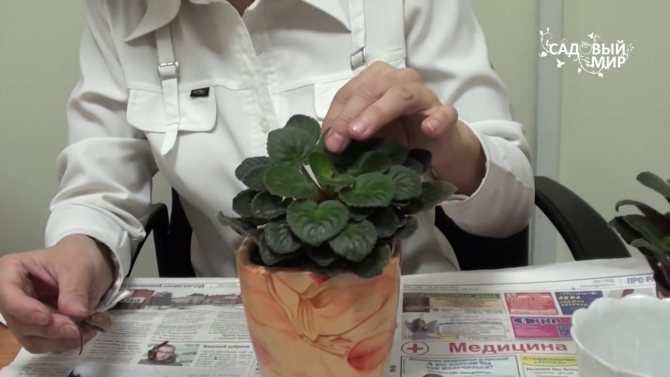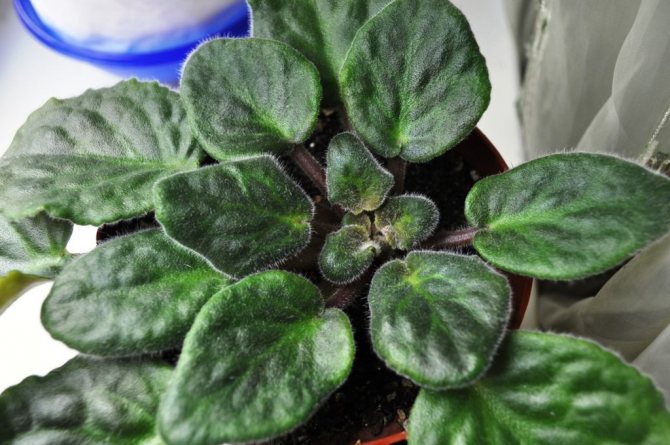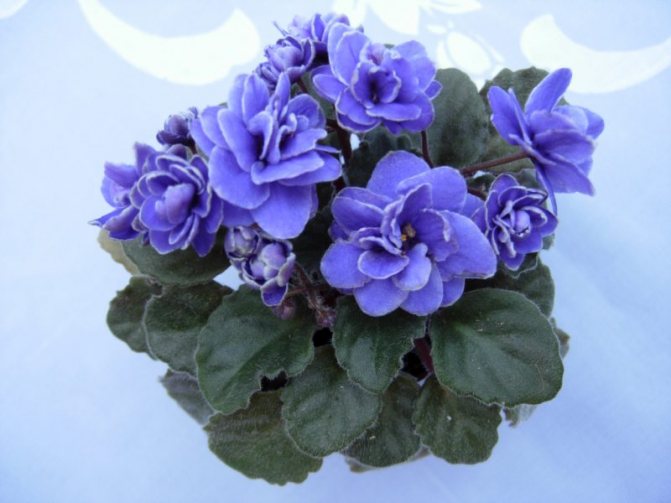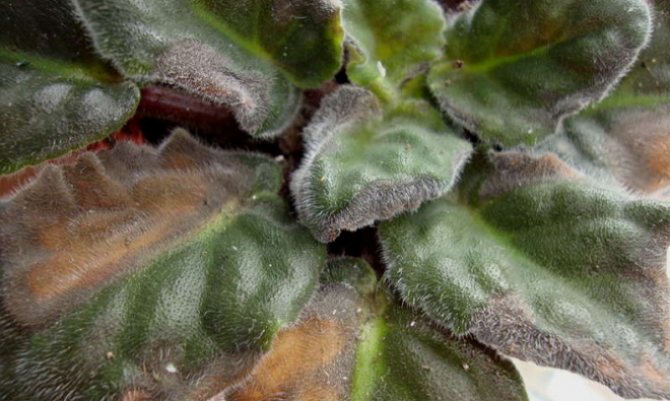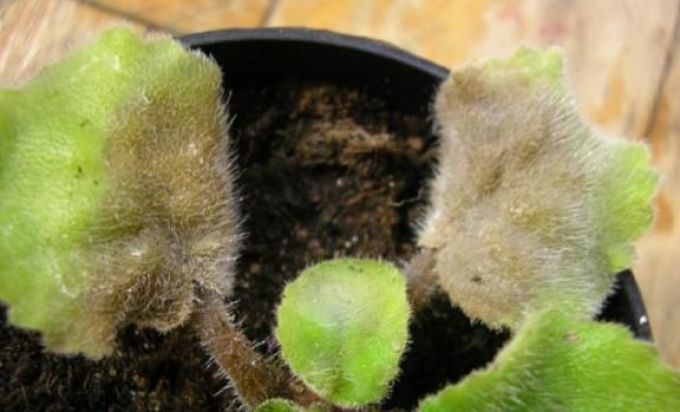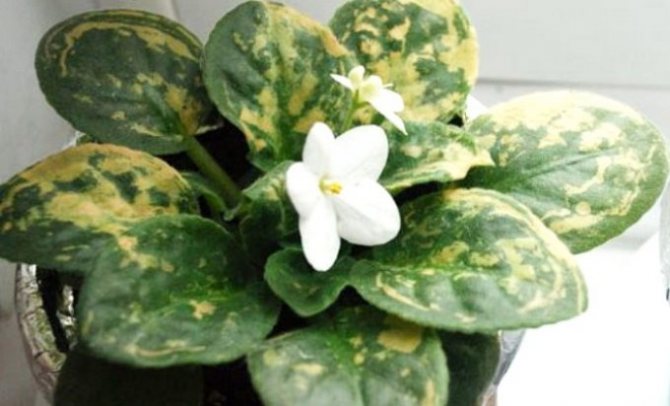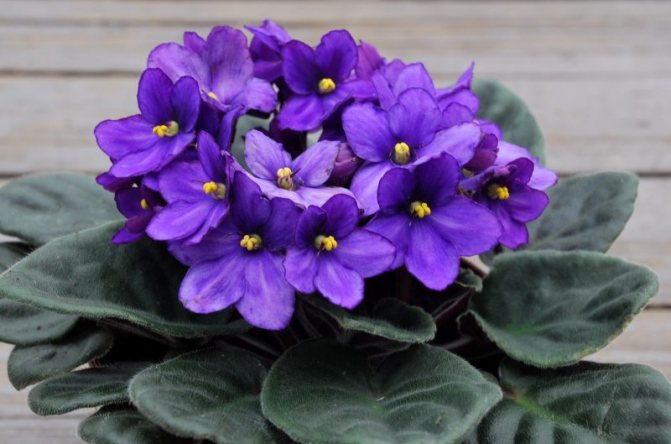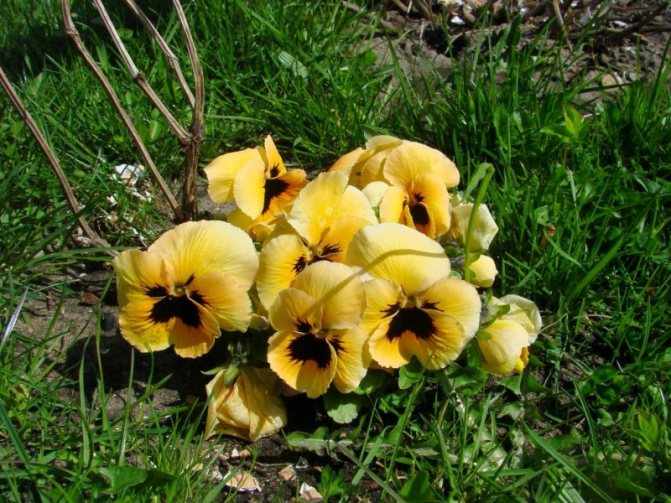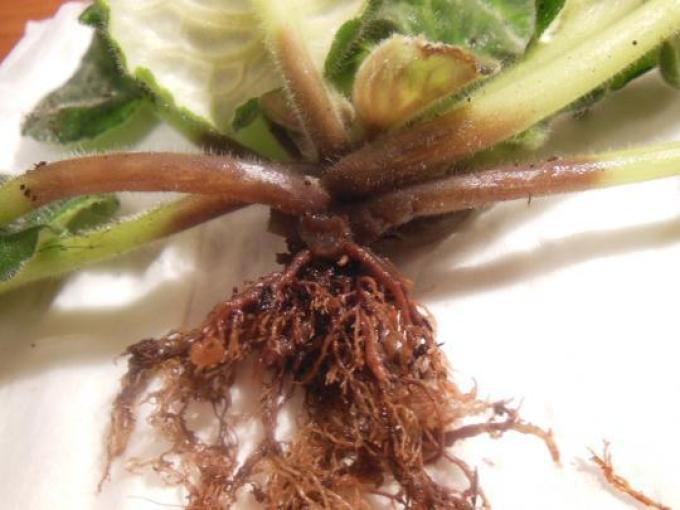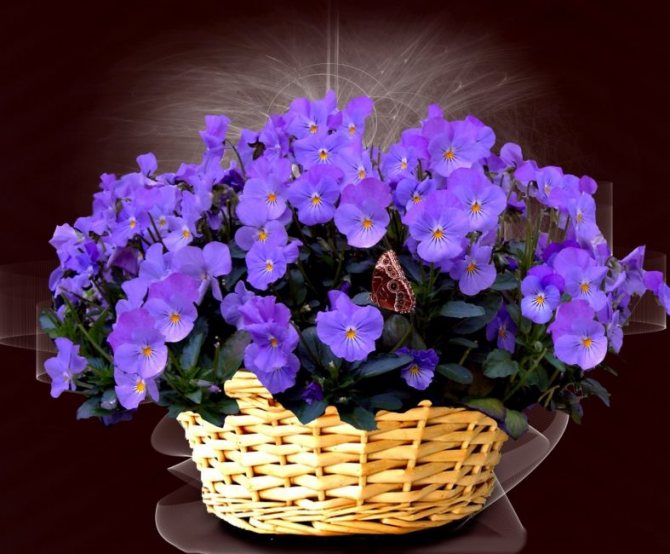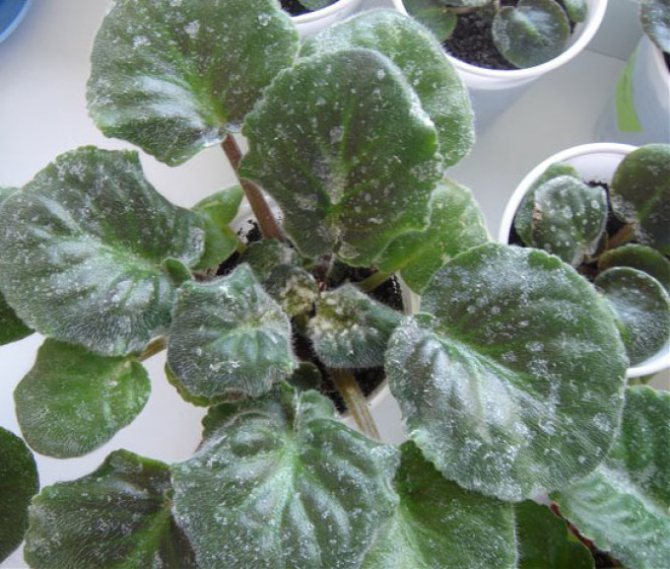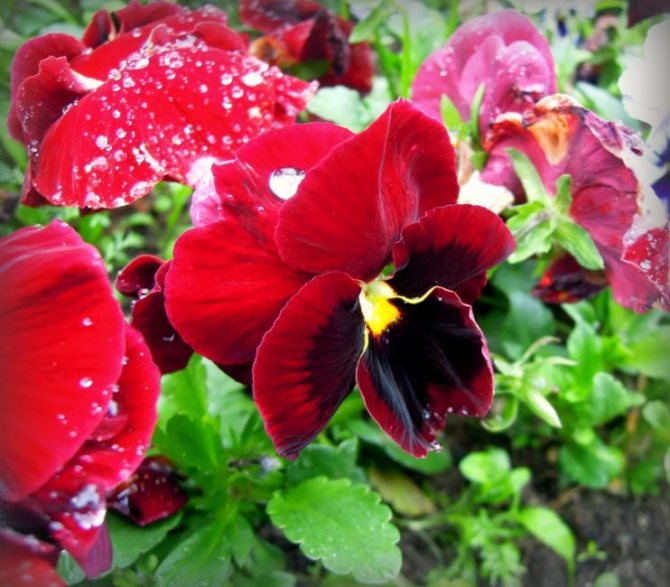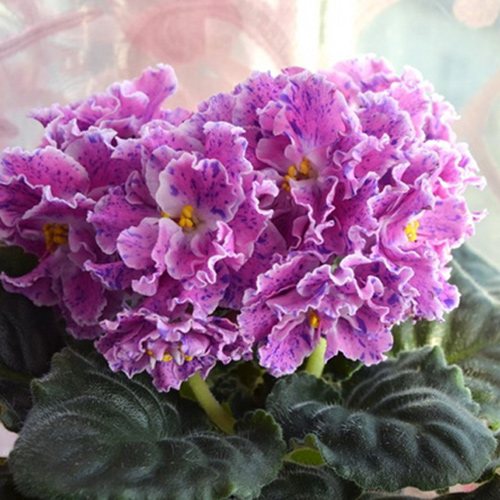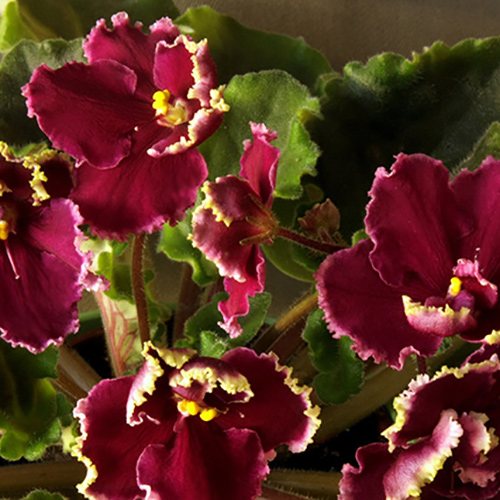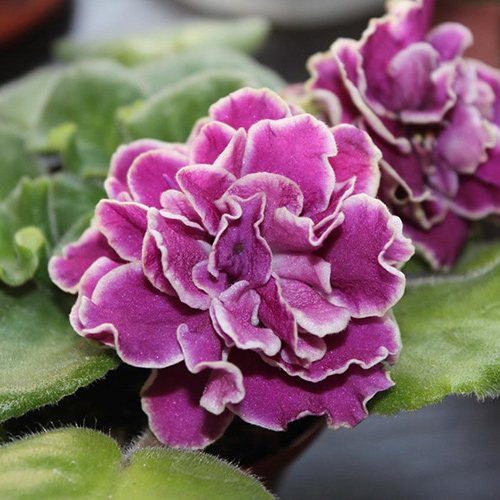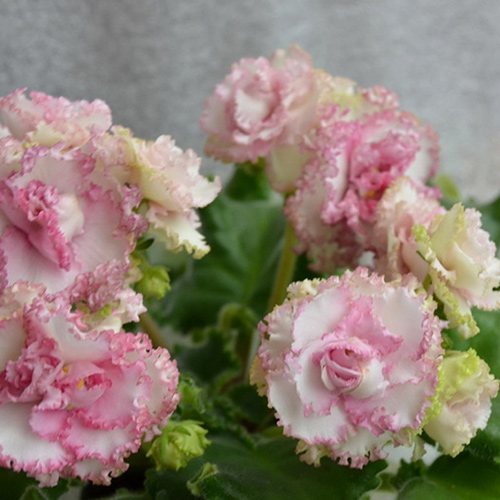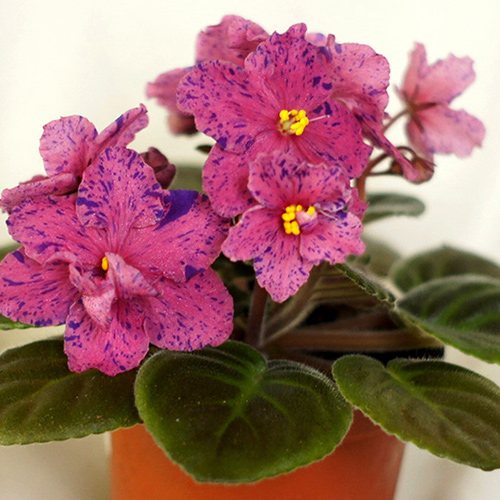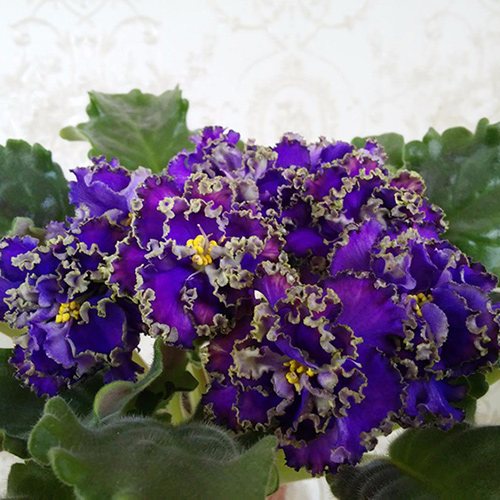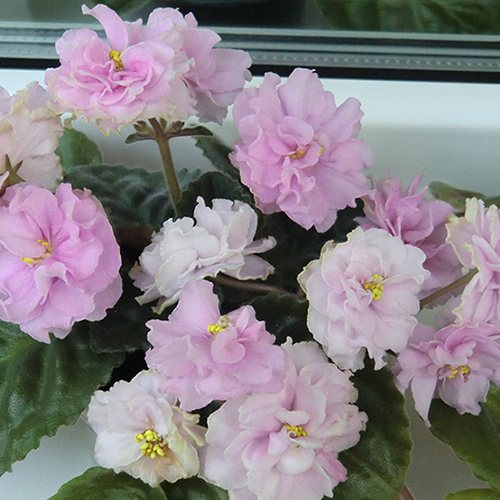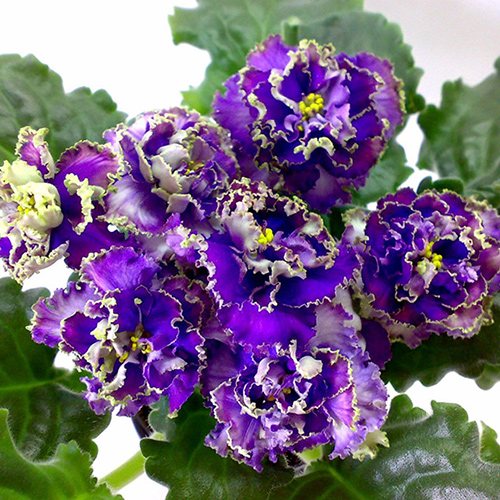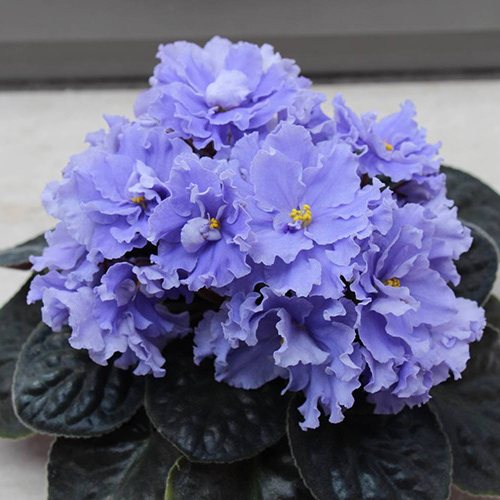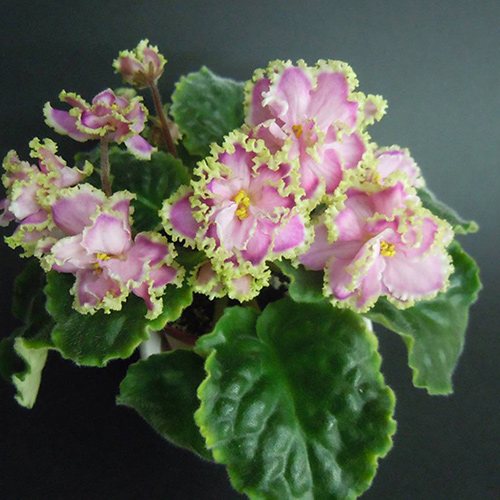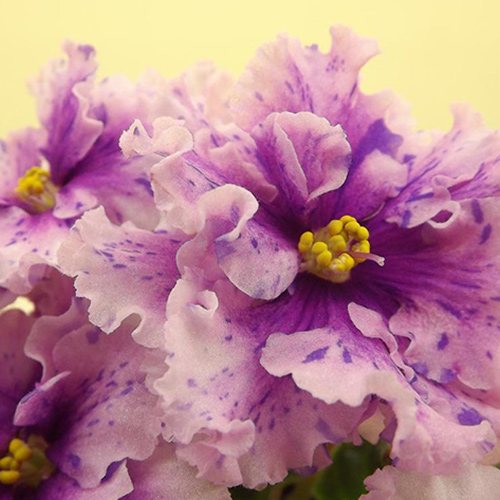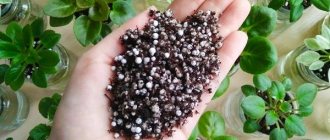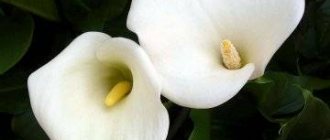It so happens that, seduced by the stories of sellers and pictures with a violent and bright flowering of violets, we buy the coveted pot, carefully carry it home and begin to wait for the violet to bloom, but this does not happen. The velvety green leaves are still pleasing to the eye, but the plant stubbornly refuses to bloom, no matter how hard we try. So why does not the violet bloom at home, what does it lack and what could be done so that this capricious beauty still deigns to throw out the buds and please us with delicate petals? This is what I want to talk about in order to finally find out what the reason is and how to deal with it.
The reason why the violet does not bloom is a lack of light.
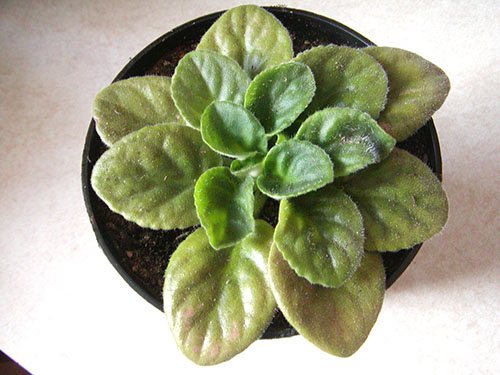
To bloom, violets need a fairly bright, but not direct light. Moreover, in natural conditions, the appearance of buds in this culture occurs at a time when daylight hours lasts at least 12 hours.
At home, indoor violets do not bloom well when, caring for them, the owners put the pots on the windowsills of the windows facing the north side. In this case, you can notice not only the absence of buds, but also a slowdown in growth, elongation and poor turgor of the cuttings.
On the southern side, violets bloom well in spring, but with the arrival of hot days they are often at risk of burns and rapid drying of the soil, so here the Saintpaulias are not too comfortable here.
On the windowsill, where violets most often grow in novice florists, it is reasonable to wait for the formation of a peduncle in the period from March to September, when the duration of daylight hours is maximum, the rest of the time you cannot do without shelves or shelves with backlight, where violets will be comfortable all year round.
Violet: a description of the plant and a brief botanical reference
Home violets are perennials. The plant is compact, some varieties are representatives of dwarf types with a creeping rhizome. The leaves are velvety, shaped like a heart. Their color can vary from salad to dark green, with various decorative blotches, depending on the variety. The flowers are painted in a wide variety of colors. The fruits are small seed pods.
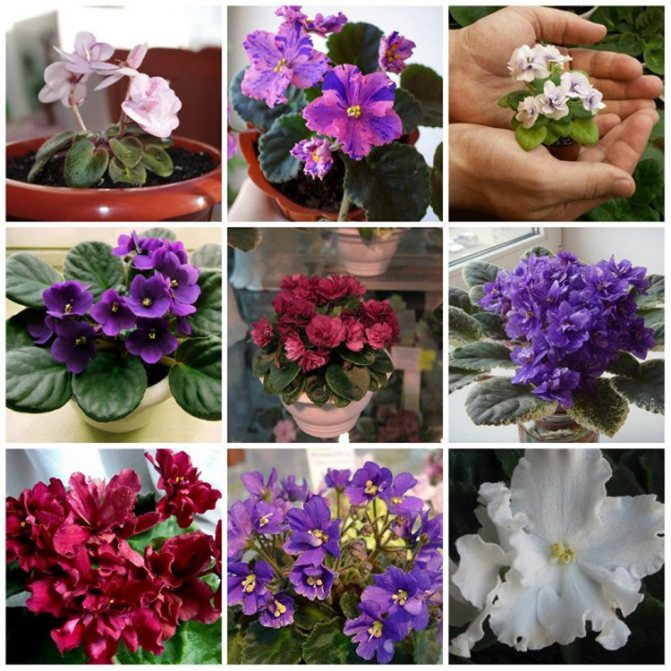

Delicate violet will decorate any home
Indoor violets belong to the Gesneriaceae family. They come from the tropical forests of East Africa. The flowering period can last all year round if the growing conditions are right. The breeders managed to get more than a thousand types of flowers, differing from each other not only in decorative properties, but also in size, characteristics of growth.
Illuminated shelves for violets
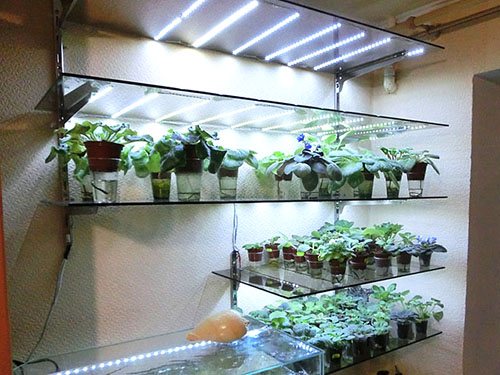

In such conditions, plants not only bloom beautifully, but also grow faster. Lighting is organized with the help of specialized lamps for plant illumination, which provide the plantings with the necessary radiation spectrum and luminous flux.
To make the violet bloom, for standard-sized sockets, lamps are suspended at a height of 20 cm from the pots, and if there are miniature varieties in the collection, the lamps are lowered to 15 cm.
Such lighting provokes plants to form the rudiments of peduncles.When they appear, the lamps are raised, otherwise, in addition to the buds, the entire green part will develop intensively, distracting the pitchfork from the flowers.
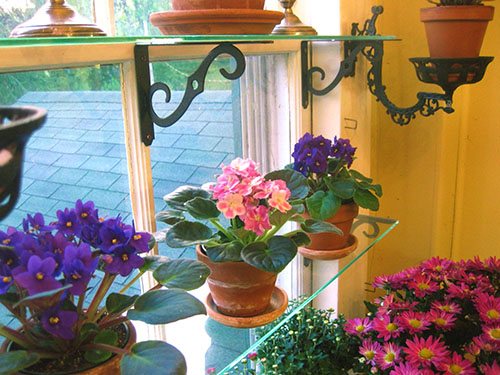

At the same time, experienced flower growers remind that different varieties have different needs for lighting. If the collection has rosettes with light or variegated foliage, such plants require less light output than violets with rich green leaves.
Therefore, the best option if the florist has at his disposal a specialized rack, where on a shelf with an illuminated violet you can find a worthy place, according to his requests and needs.
What pests are afraid of a violet
All plants have a fairly high risk of pests entering the field of vision. Here is a list of traditional houseplant sores.
- ticks;
- shield;
- thrips;
- nematodes;
- mealybug;
- aphid.


Violet infested with ticks
The best treatment is prevention, this rule fully applies to flowers. It is important to inspect the plants regularly. This is done especially carefully in spring and summer, when the air flow can bring harmful spores to the plant. Also, pests can penetrate along with a new plant bought in the store or brought cut flowers. At the slightest change in the appearance of the violet, one should begin to carry out prevention against the most common pests. It is necessary to inspect the bushes with special care, noting and analyzing every detail.
How to get rid of midges in indoor flowers using simple methods. In a special publication of our portal, we will tell you in detail how to get rid of pests in indoor flowers. You will learn the reasons for their appearance, the types of midges and their signs and measures to prevent the appearance of midges.
Pot size for planting violets
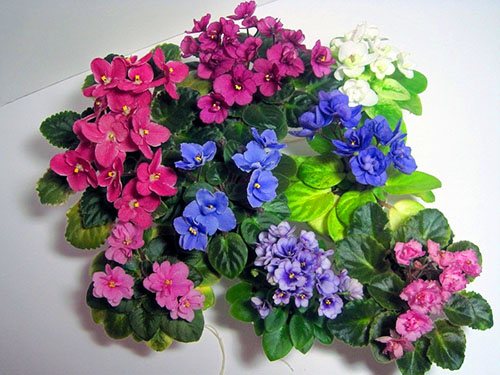

Another common reason why violets do not bloom is the wrong pot for the rosette. Forming lush foliage, Saintpaulia does not need a lot of land. If a florist, “feeling sorry” for a flower, transplants a rosette into a pot with a diameter of more than 10–12 cm, he should expect that a “grateful” plant will begin to grow, fatten, sometimes completely abandoning flowering.
Indeed, as the outlet grows, the saintpaulia is transplanted into a large bowl, but a simple rule is observed.
The diameter of the rosette should be two or three times the size of the pot. This volume of soil is sufficient both to support the development of the flower and for its lush flowering.
Pondering why the violet does not bloom, and what to do in this case, the florist should pay attention to how much space the plant takes in the pot. After all, an excess of soil not only provokes the growth of greenery, but such soil can accumulate salts, sour, become a breeding ground for fungi, pests and bacteria.
Violet varieties: names and photos
Breeding violets at home is a fascinating hobby of many people, which is gaining more and more popularity. Today, many of the most beautiful varieties of this plant are known. I would like to acquaint readers with the most popular of them.
| Variety name | Distinctive features |
Rosemary | This is a piece of jewelry for any amateur collection. The flower petals are corrugated, the background is white. Pink strokes or numerous blue splashes give the inflorescences an unusual charm. |
YAN Caprice | This flower conquers with the white foam of its lacy flowers with an amazing greenish fringe. |
Fire moths | Burgundy or dark red brushes of flowers look great against a background of green leaves. The edging of flowers is white or pale pink, rather wide. An unusual charm is given by the fact that the flowers are corrugated along the edges. |
The magic of love | This variety will appeal to lovers of large-flowered violets. The color of the huge hats of flowers is dark burgundy, one might even say beetroot, the edging along the edge is white. The rosette is standard, the leaves have a uniform green color. |
Rose of Wind | During the flowering period, the violet bush resembles a gorgeous pink rose. At the fringed edges, the pink color becomes saturated, bright, sometimes a green edging appears. |
Live wire | Rarely does anyone not pay attention to the flowers of the coral pink color and enormous size that distinguish this variety. The colors are given individuality by blue and purple spots, which are generously sprayed with flower petals. With mutation, some managed to get bushes with buds of different colors. |
Reigning beauty | The flowers are semi-double, very large, painted in a pleasant light blue shade with a thin green edging. In the process of mutation, the color gamut can significantly lighten, but it looks no less impressive. |
Your majesty | The variety, familiar to connoisseurs for a long time, has not lost its popularity today. A cap of deep double flowers of a delicate pink color bewitches with beauty. |
Water | A very unusual variety with fringed flowers of a rich blue color, which smoothly turns into pink to the edges. A thin, bright green edging adds a special charm. Flowering is profuse and long lasting. |
Sea wolf | Truly giant flowers are pale blue, they look gorgeous against the background of dark green leaves. The corollas are similar in shape to a bell. |
Winter smiles | Indeed, looking at the semi-double-type star-shaped flowers, one immediately recalls the play of sunlight on the winter snow. Their color is pink, turning into crimson to the edges. Ruffled petals are framed with a thin green edging. |
Bold party girl | Gorgeous uzambara violet, home care for which does not cause much trouble. Terry flowers, painted in a delicate pink-lilac color, are very similar to the skirts of dancers. At the edges, the pink color becomes lighter, in the center - it is saturated. The petals are abundantly strewn with blue blots. Simple green leaves shade this beauty. The variety is prone to mutation, which often results in chimeras. |
Spring rose | A real miracle of selection. Outwardly, the flowers resemble white peonies, decorated with a thin green edging around the edges. Flowering is long and abundant, corollas retain their decorative properties for a very long time and do not fade. Light green leaves with characteristic teeth. |
Florists also have heard of the violet tree. You will not find it at home, because the size is very impressive. And it has absolutely nothing to do with indoor plants. The plant owes its name to the intoxicating sweet scent released during the flowering period.
Temperature setting to make the violet bloom
You can make violets bloom by adjusting the temperature in the room where this ornamental culture is grown. The optimum temperature for Saintpaulias is considered to be in the range of 20-25 ° C.
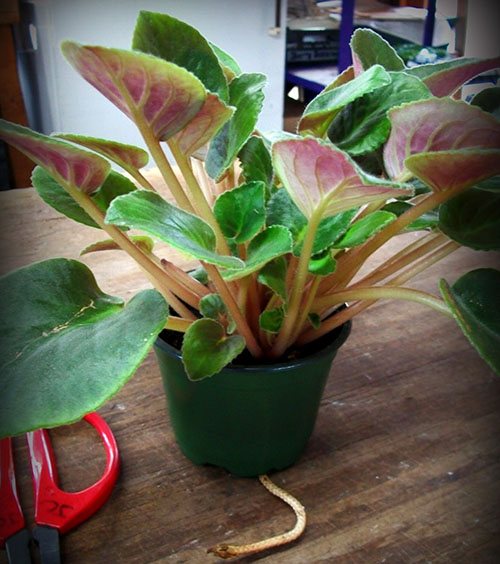

If the temperature in the room is higher, the intensity of flowering decreases, and the flowers that appear quickly, sometimes without even opening, wither. In addition, the abundant peduncle formation in the heat greatly weakens the violets, which then require a long accumulation of strength.
How to care for a violet to bloom? When it is not possible to transfer the plant to a cooler place, it is better to cut off those few buds that have formed. This will save the strength of the plant for a time when the heat subsides. In addition to this measure, a fan can be placed next to the plants, preventing cold air from entering the outlets, and protecting them from the scorching rays of the sun.
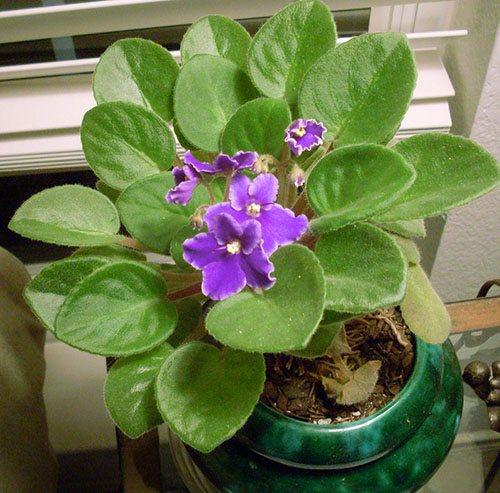

If the temperature conditions are met, violets show all their decorative qualities. fantasy varieties react especially well to a decrease in temperature, the main charm of which is in bright fringe, border on petals and unusual color of foliage.
How to seat the kids?
Adult plants, growing up, form children, which often impede the development of the mother's outlet.In such situations, it is necessary to carry out the procedure for separating daughter bushes, which is best carried out in the summer, so that the mother plant has enough time to recover by the arrival of winter.
For this:
- The baby is carefully dug out with a sharp object so as not to damage the mother's socket.
- With many leaves and a small number of roots, part of the leaves on the separated rosette is cut off.
- The baby is placed in a flower pot with a substrate similar in composition to the soil mixture in a container with the parent specimen.
- The new plant is moderately moisturized and moved to a warm place with a lot of diffused light.
Air humidity is a prerequisite for flowering
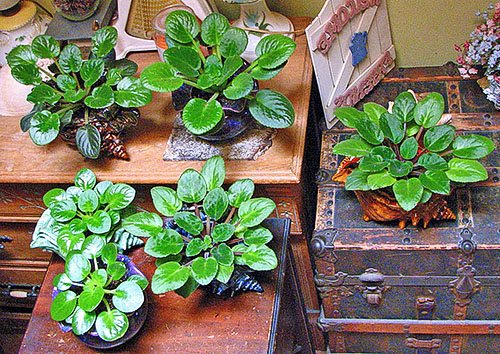

As well as the high temperature and excessive dryness of the air, this is a good reason why violets do not bloom. For comfortable development and flowering, Saintpaulias need an air humidity of about 50%.
In an apartment, especially in the period from autumn to spring, when the heating devices are working, the air is sometimes much drier, which slows down the growth of the outlet and the set of buds. Especially strongly from such a lack of care for indoor violets, why they do not bloom well, young rosettes and plants already "aged" suffer, which in the near future need rejuvenation and transplantation.
You can provide plants with comfortable conditions for the formation of peduncles by using household humidifiers, as well as placing trays of water on the racks with flowers. In special cases, when the appearance of the plant suffers, the outlet is sprayed with warm water without affecting the flowers. The procedure, if necessary, is repeated after two or three days.
Plant feeding
In order for Saintpaulia to bloom beautifully, you need to feed it with mineral fertilizers. This is done only 2 times a year. In the spring, the violet is fed during the period of active growth. The second time this is done after it has faded, that is, in the fall. In winter, the plant does not need to be fed when it is at rest. Complex mineral fertilizers are used for this.
Although it is recommended to apply fertilizers 2 times a year, this does not mean that they are used once. For example, in the spring they are brought in 2 times a month and they are used with the same frequency in the fall.
During transplanting, plants use a small amount of humus or humus for feeding. It should also be noted that only adult plants need to be fed.
Watering as a measure of care for violets
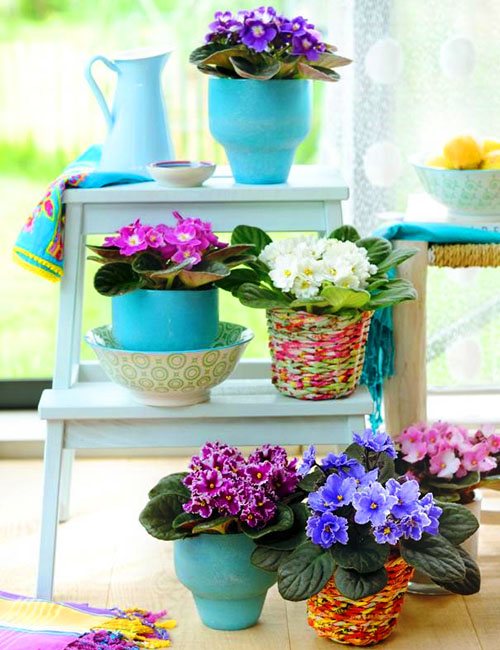

As for spraying, only warm water with a temperature of 2-3 ° C than the air in the room is used to irrigate violets. Beforehand, the water must be defended, leaving it in an open container for 24–48 hours. During this time, volatile chlorine compounds leave the liquid, and salts are precipitated, which do not in the best way affect the quality of the soil and the condition of the plants.
Warm water for irrigation is extremely important during the cold season. Moreover, the danger lies in the possible decay of the roots, which threatens plants both on illuminated shelves and on window sills.
When violets do not bloom in spring, the reason sometimes lies precisely in the fact that root decay has begun inside the soil coma. Therefore, between waterings, if water gets under the roots of the plant from above, the top layer of the soil should dry out. If the saintpaulias are watered through a sump, then the excess water must be removed 20-30 minutes after watering.
Diseases of violets and their treatment - photos of damages
Saintpaulias are very delicate and fragile plants that are prone to a variety of diseases. But still, florists massively grow magnificent violets. Leaf diseases, photos and reasons will help readers figure out how dangerous a particular disease is, and also enable a person to react in time and save a beloved bush from death.
Why violet leaves turn yellow, and how to fix it
The owners of indoor violets noticed that their wards' leaves turn yellow from time to time. There may be several reasons for this:
- dying off of the lower fragments as a result of the natural aging process;
- insect damage;
- defeat by infectious diseases;
- incorrectly placed pots;
- unsuitable soil;
- violation of the regime of watering and feeding.
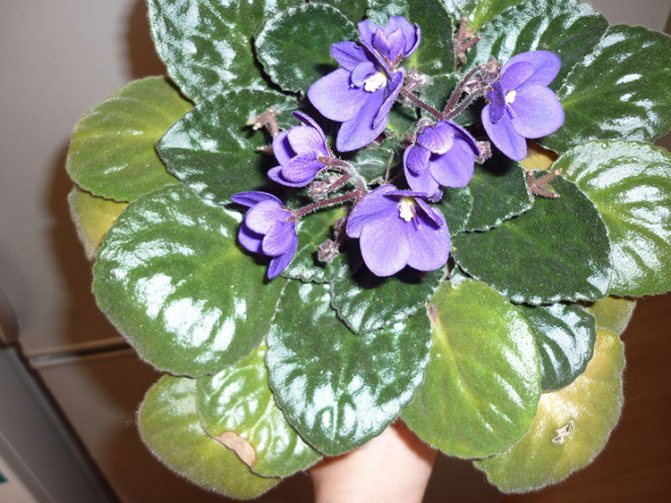

Violets can "hurt" due to waterlogging or dryness
If the lower tier of the rosette begins to turn yellow, then the reason is, most likely, depleted soil. You can cope with this trouble by transplanting a plant. If it is not possible to urgently transplant a bush, then a few grains of citric acid or a couple of drops of vinegar are added to the water for irrigation. This will help the nutrients dissolve better and normalize acidity. But in the future, it is still better to transplant the violet.
What to do if stains appear on the sheets
The appearance of spots on violet leaves is a cause for alarm. The reason can be both banal improper watering and the negative impact of parasites. Also, the wrong choice of the location of the pot can provoke such a phenomenon. It is not possible to quickly and correctly determine the cause of the stains. It is worth taking a closer look and determining their nature.
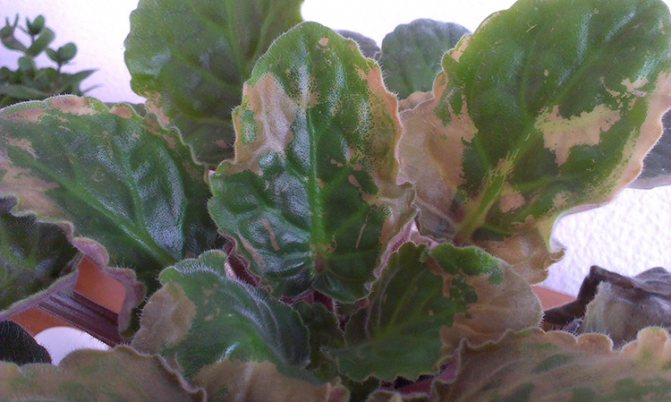

Yellow-brown spots may appear due to parasites
Yellow-brown spots indicate sunburn and an abundance of light. First of all, the edges of the leaflet are affected. The most affected is the side of the bush that is closest to the light source. To eliminate this phenomenon, it is necessary to provide the violet with partial shade, to protect it from direct sunlight.
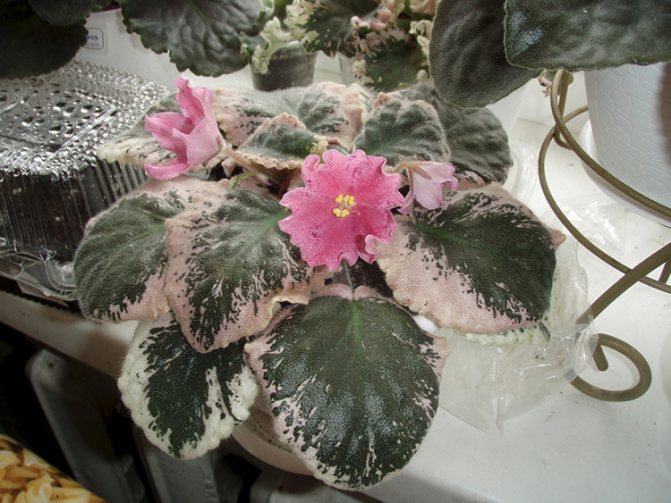

Violet infested with powdery mildew
Spots of white, similar to dusting with flour, are an alarming signal of the development of a fungal disease (powdery mildew). The plant must be separated from healthy plants and disinfected with special preparations.
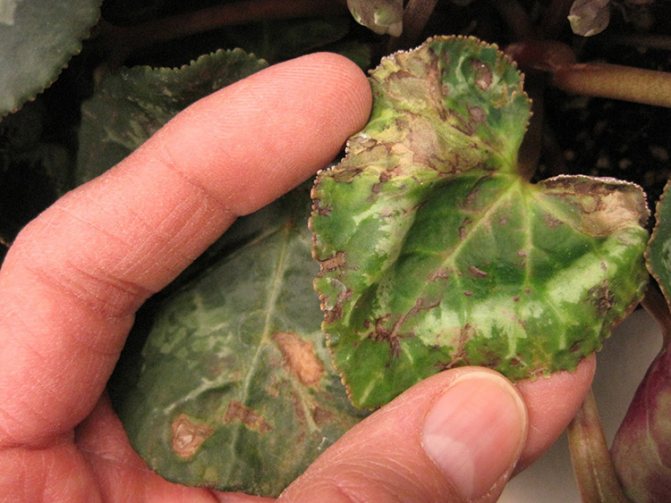

Brown spots are a sign that the plant is suffering from a lack of moisture
Brown spots indicate insufficient moisture. This is not necessarily due to poor watering. It's just that the soil is no longer able to retain the necessary moisture. Transplanting into a new soil mixture and removing the affected leaves will help to solve the problem. The reason for the appearance of spots after wintering can be an elementary lack of vitamins and nutrients. In this case, the violet should be pampered with complex fertilizers.
Why violets do not bloom, and how to care for them to bloom
The main reason that violet does not bloom, it turns out that the lighting level is insufficient or the daylight hours are too short. The plant loves bright lighting, but does not tolerate direct sunlight. The length of daylight hours should be at least 10-12 hours. To solve this problem, it is recommended to build a rack with artificial lighting located near the window.
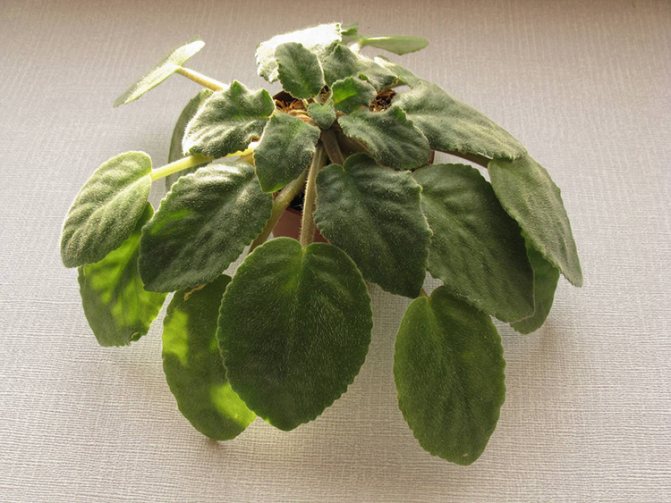

The plant may not bloom due to stress or a change in its usual place.
Incorrectly sized pot is also the reason for the long absence of peduncle formation in violets. The fact is that a plant blooms only when its root system is entwined with an earthen lump in a pot. If the capacity is too large, then flowering can be expected for a very long time.
Lack of colors - the first sign of the development of such a dangerous disease as root rot. You will have to get the bush out of the pot and carefully examine its root system. If the suspicions are confirmed, then the "head" of the violet is cut off and re-rooted. Otherwise, the plant will die.
How to feed violets so that they bloom?
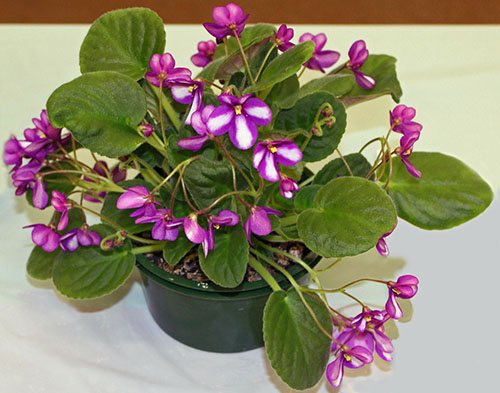

Asking what to do if violets are not blooming, indoor plant lovers often force the plant to behave this way.It's all about illiterate or excessive feeding, causing serious damage to the health of the outlet and its ability to produce flowers.
The most common mistake is an excess of nitrogen in the soil, which makes the violet not bloom, but give more and more leaves and form stepchildren, which, as they develop, take away strength from the parent outlet. The violet plant, doomed to excessive nitrogen consumption, is less resistant to diseases spread by fungi.
You can make a violet bloom only with very moderate and competent use of fertilizers. The greatest need for feeding is experienced by plants that have just undergone a long and abundant flowering. In this case, complex compositions are used for flowering crops, and the content of phosphorus and potassium in them should be twice as high as nitrogen.
From florists you can hear the question: "How to feed violets so that they bloom after transplantation?" But in this case, it is better not to rush at all with the application of fertilizers, since the plants requiring acclimatization will not be able to correctly perceive the mineral substances that have entered the soil, and besides this, the fresh soil necessarily includes everything necessary for growth.
With the help of a slight increase in the acidity of the soil at the stage when the violets are laying the buds, it is possible to achieve brighter flowering in varieties on whose petals contrasting shades are combined, there is a fringed border and placers of colored splashes.
When violets bloom
Experts who know everything about indoor violets claim that plants are able to delight with abundant flowering throughout the year. If the flowering is scarce or has stopped altogether, the conditions of detention must be changed. The main factors that ensure the continuity of flower bud formation are:
- good lighting without direct sunlight;
- maintaining the moisture level in the soil;
- sufficient air humidity;
- regular application of fertilizers and dressings;
- correctly selected substrate;
- compliance with the temperature regime;
- the correct size of the pot;
- no signs of disease in the plant.
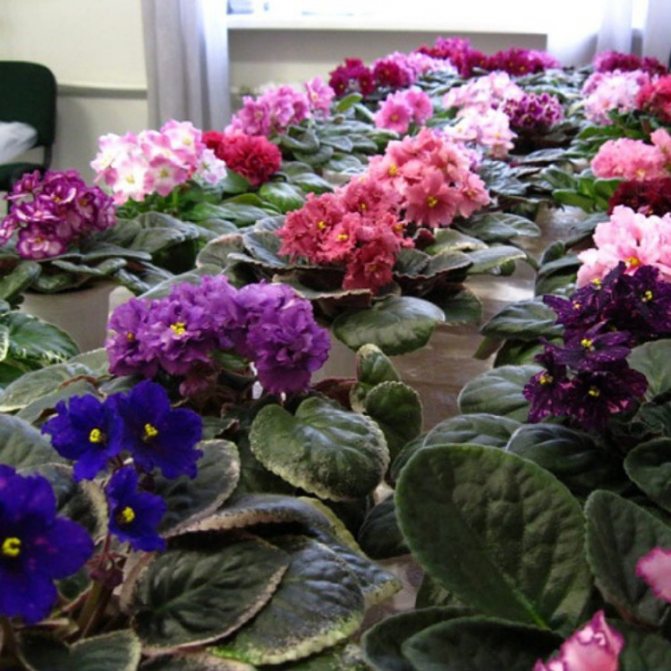

Mass flowering of violets is a mesmerizing sight!
As a rule, a young plant can bloom as early as the second year after planting a young rosette grown from a leaf.
Selection of soil for lush flowering violets
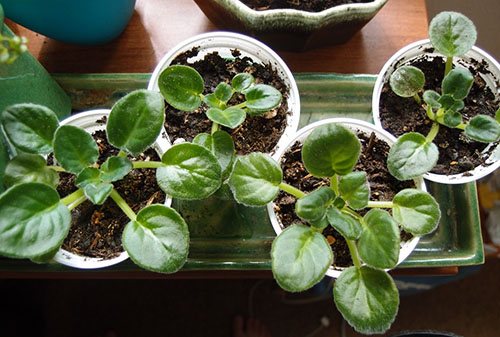

The reason why the violet does not bloom may lie in the untimely transplanting of the plant or the wrong selection of the soil mixture. Usually, Saintpaulia rosettes are transferred to another soil after about two flowering, that is, twice in 1–1.5 years. If this is not done, the plant lacks nutrition, it weakens and refuses to bloom over time.
But what about a situation when a florist is making every effort, caring for a violet so that it blooms, but there are practically no buds? The error may lie in the wrong soil. Violets react extremely poorly to dense soil that accumulates a lot of moisture. In such a mixture, the plant hardly forms a root system, and the existing roots rot.
In order for the soil to retain lightness and friability, but not to lose its ability to retain moisture, vermiculite and perlite are added to it, and natural antiseptics are used - sphagnum moss and powdered charcoal.
Sphagnum in the form of a crushed mass is added to the soil, and whole plant stems, along with expanded clay and foam crumbs, are used as drainage, which is mandatory for violets.
When planting violets in ready-made or self-selected soil, be sure to check its acidity. For saintpaulias, soil with a slightly acidic reaction is most suitable. The allowable level can vary from 5.5 to 6.5 units. Taking advantage of all the recommendations for caring for indoor violets, the florist will definitely get a luxurious bloom of his favorite Saintpaulias.
Reproduction of violets by cuttings
The most popular option is the propagation of violets by cuttings.It is best to choose a leaf from the middle of the outlet, that is, neither too young nor old. It can be pinched off or carefully cut off with a small sharp knife so as not to damage the plant and leave a tall stump after that. Cut the stalk as close to the ground as possible.
It is desirable that the black is at least 47 cm long. It must be cut obliquely, at an angle of 45 °. If the cut surface is 2-4 cm long, this will be enough for the leaf to take root well and give more rosettes.
Not all leaves take root, so it is advisable to take 2-3 leaves at once from the variety you like, if possible. It is not at all necessary to buy a pot for rooting such a leaf. You can get by with disposable plastic cups or yogurt containers. Shallow cups are best. If there is a shallow container of large diameter, then several leaves can be planted in one container at once. The distance between them should be at least 5 cm, so that later it would be convenient to dig them out.
Not all violets propagate equally well by cuttings. There are so-called chimeras - these are varietal flowers of unusual colors. Their leaves root well, but they do not retain the peculiarities of color or the beautiful shape of the leaves.
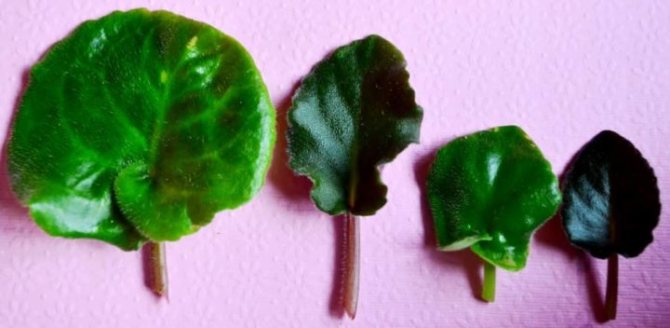

Violet propagation by leaf
How to grow a violet from a leaf, in the ground or in water, interests many novice florists. In fact, both methods are equivalent. In both cases, this environment must be disinfected, for example, using activated carbon. If the cutting is placed in water, care must be taken to ensure that it does not rot. Water should be taken warm, but not hot. The roots of the leaf will appear in about 1-2 weeks, and then it can be planted in the ground. Some growers wait longer - until new shoots appear, and this happens after about 1-2 months of being in the water. Shoots appear from the cut. If the grower decided to wait for their appearance, then you still need to guess so that they grow up enough so that they are not sprinkled with soil when planting. Do not bury the cutting too deeply, otherwise the sprouts will not appear soon. The maximum depth is 1.5 cm.
Some believe that violets sprouting in water will bloom faster. In fact, this is a controversial issue. Experienced growers who know how to care for violets at all stages of the development of this plant will probably say that when grown in water there is always a risk that the cutting will begin to rot. The water quality does not always meet the requirements of this plant.
Additionally
Rooting violets in the ground has its advantages. But there is also a nuance here: you need to choose a super-light substrate, looser than the one that is usually used for "adult" violets. The soil mixture will have to be prepared independently on the basis of special soil for Saintpaulias, to which clean river sand (pre-calcined) is added. You can also use sphagnum moss for this, which is also sold in flower shops. Moss, even if it is fresh, needs to be lightly calcined in the oven for disinfection. So that it does not burn, it must be laid out on food foil.
The substrate should be regularly watered with warm water so that it does not dry out. Rooting in soil is slower than in water, but the risk of root rot is excluded. The seedling should be kept away from drafts. Direct sunlight is contraindicated for him. It is recommended to make a greenhouse for it, covering it with plastic wrap. Approximately 2 months after rooting, when the grown sprouts are already visible, the plant must be transplanted into a permanent container, having previously treated both it and the plant itself with special agents against pests and fungi.
Correct pruning and rejuvenation
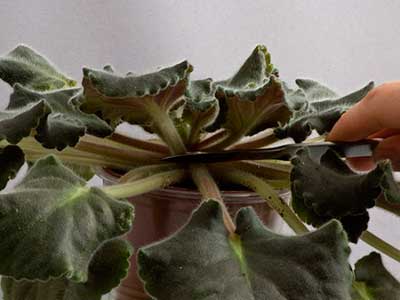

In Saintpaulias, it is necessary to remove all faded flower stalks and yellowed lower leaves, without waiting for them to dry out.
After 3 years, the plant can be considered old, it blooms worse, the stem is stretched and ugly bends. Take the best leafy cuttings and root them.
You can rejuvenate the violet. To do this, the stem is cut off at ground level, cleaned with a sharp sterile knife, sprinkled with a mixture of crushed activated carbon and heteroauxin, allowed to dry for 6 to 12 hours. Then it is placed in water or planted in light soil for rooting.
Care after purchase
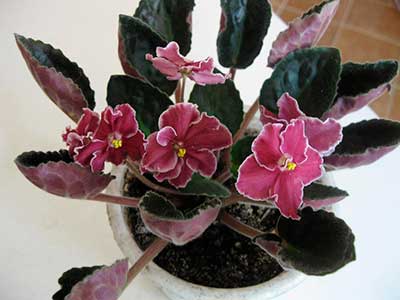

At an exhibition or in a store, you purchased a Saintpaulia and brought it home. What to do next?
- Examine the violet with a magnifying glass for thrips or mealybugs. If necessary, spray the plant with an insecticide to avoid infecting the entire collection.
- Remove any dried or broken leaves and peduncles.
- It is better not to transplant the violet immediately after purchase, but if it was grown in peat, you cannot hesitate.
- Water the bush only if it is dry.
It is correct to isolate the violet for 2 monthsso that diseases or pests not detected in time do not migrate to other plants. In practice, few people withstand quarantine.
Important! Set the saintpaulia apart from other flowers and observe it for at least two weeks. There were cases when even a shield was brought home with a purchase.
Folk remedies for stimulation
In addition to industrial, ready-made fertilizers, you can also use universal, folk fertilizers that are available to everyone.
Black tea
Plain black tea should be mixed with soil in a ratio of 1/3 (3 parts of earth). This mixture will keep the plant from drying out. Used during the transplant period.
Coffee grounds
You can simply pour the thick into the pot, or you can mix it with the ground.
This fertilizer is identical in properties to that of a brewed fertilizer.
Citrus peel


Such fertilization helps to strengthen the plant's immunity and protect it from pests and diseases.
Cooking method:
- Peel washed fruit
- Put the peel in boiling water for a day
- Strain the resulting infusion and dilute with water 1/10
Onion
Onion husks will rid the violet from pests.
You just need to boil the husk, let it stand until it cools completely and strain the resulting consistency. Plants can be sprayed with this infusion.
Use after preparation, do not store.
Sugar, glucose
Sugar fertilizers are great for plant growth.
For cooking, you need to take a liter of water and dilute 1 tablespoon of sugar and 1 teaspoon of glucose in it.
Use the infusion immediately after preparation.
Saintpaulia problems caused by mistakes in agricultural technology
But sometimes problems with violets arise not because of infections or pests, but because of non-compliance with the rules of cultivation.
- Violet does not bloom - insufficient lighting, heat, cold, too large a pot.
- Flowers are deformed, dry - dry air, heat.
- Reducing the size of leaves and flowers - dry air.
- A small number of peduncles - poor soil, lack of nutrients, poor lighting.
- Leaves rise ("hands up") - lack or excess of lighting, close placement on the windowsill.
- Leaves grow too dense, deformed or lighten - too much light
- Leaves wither - overflow, overdrying, overheating of the roots.
- Yellowing of leaves - excessive lighting, low humidity, improper watering, overfeeding with fertilizers.
- Yellow or white spots on the leaves are sunburn.
- Brown spots - cold water has spilled on the leaves.
- Pale leaves on long petioles - low maintenance temperature.
The head of the Saintpaulia club "Violets on the Neva" tells about all the secrets of caring for violets:
What varieties bloom all year round?
Emerald Pink (LLG / P. Sorano)
Semi-miniature with light coral, sometimes pink flowers, with a light green border.The small size of the flowers more than compensates for their number. The variety is quite easy to care for and breed, so it is suitable even for beginners.
Anastasia (Sorano)
A variety of two-tone violets, which is absolutely simple, but the sky-blue color gives lightness, fabulousness, mystery. Semi-double flowers, with corrugated edges. The foliage is medium green.
Rod of Pansies
The flowers are double at the edges, most often arranged in two rows - small on top, larger below.
Variety Lions Pirates Treasure
The middle of the flower is bright pink. Purple edging along the edge. A semi-double variety, the leaves of which also have a wavy texture at the edges.
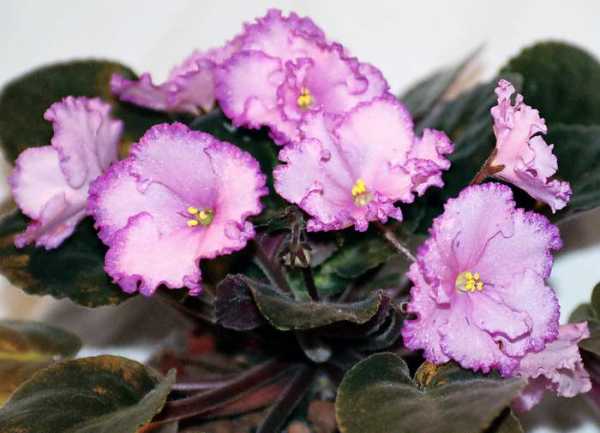

Cinderella's dream
Flowers are white, with lilac edging, semi-double. The edges are jagged. The leaves are wavy.
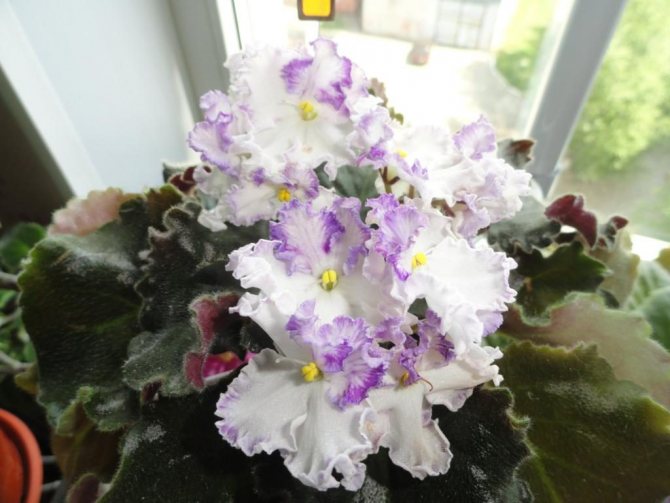

Melody Kimi
Variety of deep blue color with a light middle.
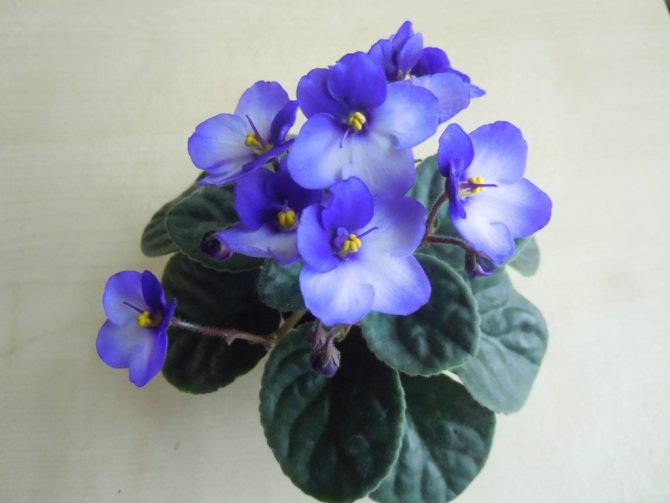

Output
Those who were able to grow this stunning flower from a simple leaf will remain faithful to it for a long time. It is impossible to remain indifferent to the violet. Some kind of their own, special aura emanates from these plants. Having grown her at home, you can fully appreciate those feelings, that harmony that appears literally nowhere.
And in order for the plant to please your eyes and amaze the guests of your home, you need to follow only a few rules and do not forget about them. Suitable temperature and humidity, sufficient light, timely transplantation and proper watering.
Solar and artificial lighting
Indoor violets love good, but diffused lighting. Direct rays of the sun are destructive for them, from them the leaves of the plant get burns, get sick and fall off. But without enough sunlight, the violet will not bloom. For normal growth, it needs to be well illuminated for 10 - 14 hours a day. Note that Saintpaulias with dense, dark green foliage require more intense and prolonged illumination than those with light curly leaves.
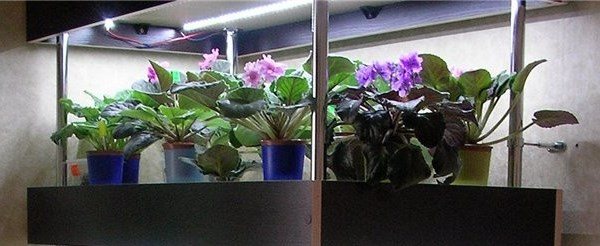

If necessary, arrange artificial lighting for flowers using a fluorescent lamp, phytolamp, or LED strips, violets grow beautifully under such light.
Lighting of a plant from one side can distort the shape of the flower rosette - after all, the leaves are drawn towards the light. Therefore, periodically rotate the flower pot around its axis. Then the bushes will be compact, symmetrical, with lush greenery and lush flowering.
The darkness of the night is also important for the growth of the violet, otherwise its leaves become faded and it refuses to bloom.
Violets on the windowsill - signs
Violets on the windowsill destroy privacy
The incredible popularity of Saintpaulia has become the reason for many superstitions and signs with which this flower is associated. They say, for example, that a violet is a muzhegon, that is, an unmarried woman who grows indoor violets supposedly has no chance of getting married, and a married lover of Saintpaulias has a risk of being left without a husband. But if you think carefully, it turns out that among your acquaintances there are married women who have been growing violets for years. Yes, and those of your friends who got married not so long ago, you can find a violet or two on the windowsill. If you look.
Another superstition claims that the indoor violet is an energy vampire and should not be kept in your bedroom as it causes drowsiness and fatigue. But, if you think about it, violets, like any other plants, produce oxygen during the day, in the light, and at night, on the contrary, absorb it and emit carbon dioxide. And the lack of oxygen makes you sleepy. Hence the conclusion: there is no need to arrange a whole greenhouse on the windowsill in the bedroom.
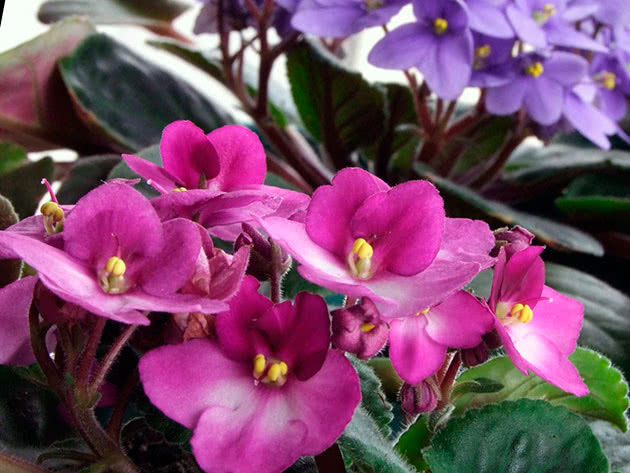

How many days does a violet take root?
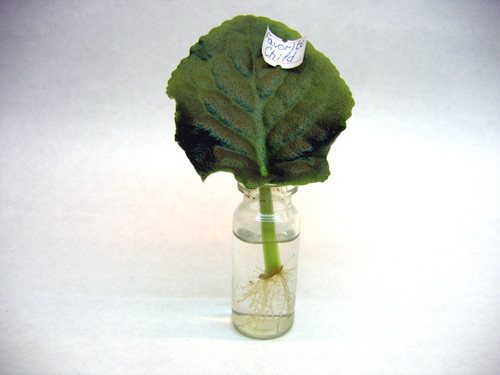

In the process of rooting, we do not change the water, but add as it evaporates
As practice shows, on average, the roots of cut leaves begin to appear approximately 20 days after they have been immersed in water. But, of course, this is not always the case.This process is influenced by the water into which the plant material was dipped, the very state of the leaf, and no matter how ridiculous it may sound, the season. Those who are engaged in the cultivation of indoor plants know that at the end of winter and at the beginning of spring, all ornamental flowers begin to develop vigorously.
Due to the fact that during this period they begin to receive much more natural light and heat, they accelerate all processes and, as a result, they begin to bloom more intensively and release leaves. These processes slow down by the end of summer, and in autumn they practically stop. In view of this, if you propagate a violet in the spring, then its leaf can take root even after two weeks. If you try to do this in the summer or autumn, then you will be able to see the first roots only after a month and a half.
Reasons for the lack of flowering
Their flowering is surprising and admirable. And here without flowering and violet not violet... And you already have other emotions. Concern and frustration. When purchased, how many pictures and stories there were.
Identifying the reasons and circumstances that do not contribute to flowering will not take much time. But to eliminate them, you may need it and more:
- How long does it not bloom? It is important to know more about your flowers. Their varietal characteristics. There are varieties of Saintpaulias with a small number of buds and inflorescences... Maybe you have such?
- With proper care, many specimens bloom up to 8-9 months... Certain varieties may not bloom. And the whole window sill with violets is strewn with flowers. Or are there problems with the entire window sill?
So let's see what needs to be done with the violet so that it blooms and pleases you.
Insufficient or oversupply of fertilizers
Fertilizing for some novice growers is becoming the main path to flowering. In their misconception. How so. After all, he used what was advised? Maybe a little?
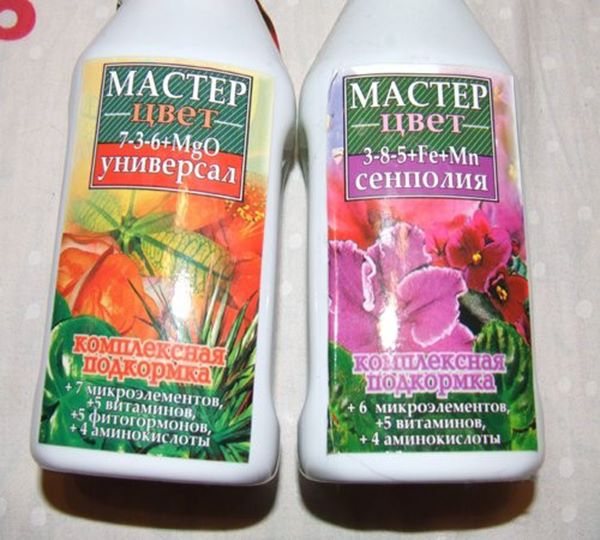

Overloading with fertilizers is even more dangerous than a small amount.:
- Lack of nitrogen - old leaves turn yellow and die off. If there is a lot of nitrogen - the plant all the efforts of the plant are directed to vegetation. Including stepchildren. Not bloom;
- Lack of phosphorus does not allow the formation of inflorescences and buds;
- Little potassium - weak flowering. The flowers turn yellow and become stained. And the leaves are curled up.
Large pot sizes
Evaluate the match between the pot and the flower. The large size of the pot will not allow you to bloom well.... It will allow roots and leaves to grow. But the buds won't appear.
Wrong ground
In nature, the violet can also be seen next to stones. Where there is also a suitable soil. You will not find them on the wrong ground.
Indoor conditions the presence of high-quality soil is of particular importance:
- It must be fertilized within a month or two after planting;
- And completely change after 7-9 months.
For the benefit of the plant. And to see full bloom.
Uncontrolled watering
It is difficult to imagine "uncontrolled watering" of violets. Put the hose down and forget? It is more correct to talk about mistakenly selected watering mode... And the methods used in this.
Moisture is the source of life. Excessive amounts of it can be the cause of adversity. And even death. There are enough examples.
What not to do:
- Water every day;
- Watering leaves and buds;
- Use cold water;
- Leave the water in the pan for a long time.
Low illumination
Beginners (without experience) flower growers are quite often under the influence and pressure of not entirely truthful information. Or not complete. And they put them on dark windowsills or in a room with no light. After all, they explained that not under the sun! As they say, I missed something ...
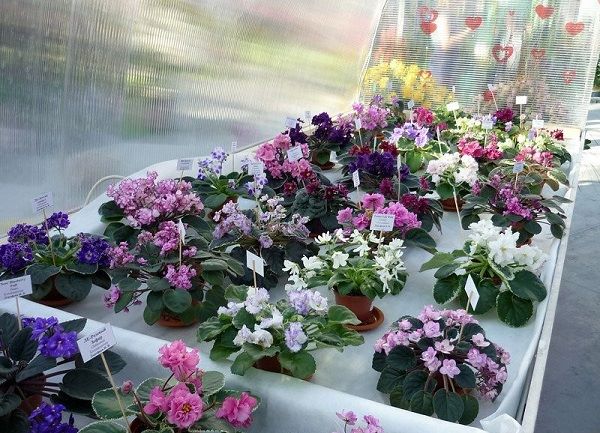

BUT violets love light... They need him at least half a day. There will not be so much - and you will not see good flowering in your flowers! Only thin leaves will stretch upward.
Non-compliance with temperature conditions
Comfort and temperature. We are not in vain interested in the temperature for the day. So it is important for plants to know.At what temperature do they grow and bloom better? And what vibrations are dangerous and harmful for them? And create suitable ones.
Circumstances vary. And the situation. But too low and high temperatures do not contribute to the flowering of Saintpaulias... They are hardy. But below 14-15, and above 27-28 will already affect their condition.
Fertilizers for home violets
Top dressing is recommended only during the period of intensive growth, as well as flowering. In autumn and winter, fertilizers do not need to be applied to the soil.
For abundant flowering, Saintpaulia requires potassium and phosphorus, and nitrogen is necessary for the growth of leaf plates. While the plant is young, it is fed more with nitrogen fertilizer, and the adult specimen needs more phosphorus-potassium fertilizer. Do not apply a lot of nitrogen to the pot with an adult violet, as this can cause the lack of flowering.
Variety of violets "Bowl"
These are some of the most beautiful varieties of different colors and peduncle shapes. The bases of the petals are less accrete than those of the bells, but the flowers do not fully open, retaining the shape of a wide bowl.
Ming dynasty
The most beautiful variety of this type of violets: the flower stalks are white with a pink tinge along the edge of strongly corrugated large leaves.
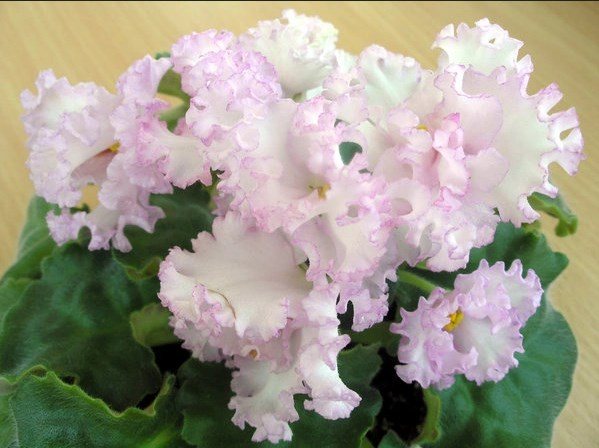

Bu Meng
Varieties of violets are terry and semi-double. The flowers are light blue. The petals are located in several rows, have a rounded shape, not corrugated.
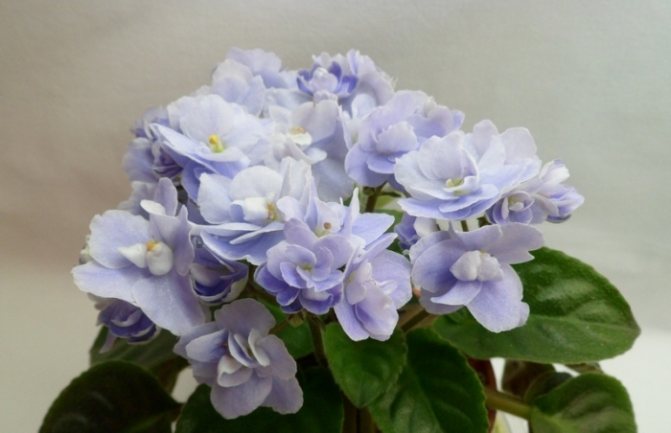

Useful properties of violets
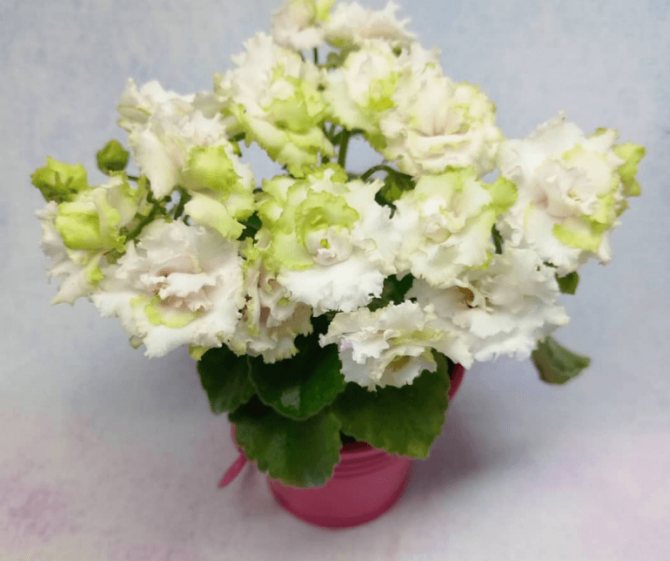

The violet is beautiful and healthy. Flower infusions are used in folk medicine for bronchitis, atherosclerosis and rheumatism. The leaves contain acetylsalicylic acid. On the basis of the extract of the leaves and flowers of the violet, anti-aging, anti-inflammatory and tonic agents are produced. Essential oil is an indispensable attribute of perfume compositions.
Removing leaves to stimulate flowering
Everyone wants to achieve a reasonable combination of leaves and buds when leaving. For newbies, there are questions and doubts. For experienced florists, the procedure is simple.... They don't even think about how to delete sheets:
- With a slight movement of the fingers left and right, they gently break off the leaf at the base (near the stem). Do not leave any stumps. And they do not process anything;
- Some hobbyists use tweezers and nail scissors. And treated with crushed activated carbon.
They also know exactly which leaves to remove. You need to remove old, dried or yellowed. From the bottom rows. To preserve a compact bush. And also with a strong thickening of the bush. There are many leaves, but few flowers. They can even stimulate bud formation. For flowering Saintpaulias, 3-4 rows of leaves are enough for the plant.
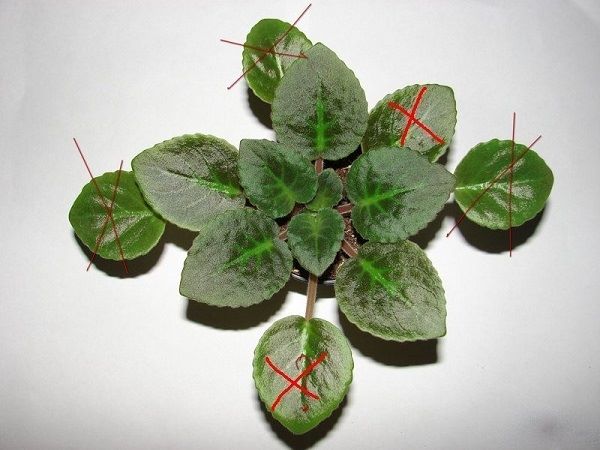

Important! Leaves should not be plucked from the middle of the trunk.
How long does it take to bloom after planting?
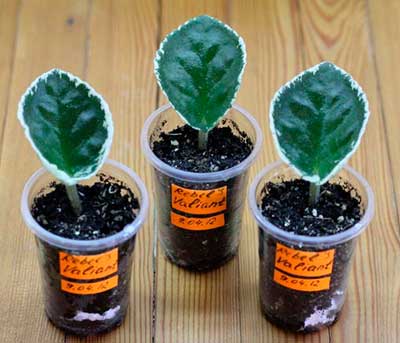

It is difficult to say unequivocally after what time flowering will come, even, perhaps, impossible. Each variety of violets has its own terms, it is approximately from 8 months to 1 year.
Although, even when planting one variety, the plant may begin to bloom for the first time at different times.
Some varieties bloom quite quickly, even early, and some will not bloom until they have sufficient leaf mass. There are varieties that develop for a very long time. The first flowering of such violets, possibly after even 1.5 years.
Some people use growth stimulants, artificial additives to speed up the process. But in these cases, the plant most often dies.
Features! In violets, everything is like in humans - someone is absolutely healthy, someone is susceptible to illness, someone grows quickly, and someone after more time.
Follow-up care and re-flowering
After such an abundant flowering, the violet bush rest is required to build new foliage... After all, the peduncle can appear from the leaf axil only once.
Therefore, for the repeated abundant flowering, the bush begins to prepare only six months later, so as not to completely exhaust the Saintpaulia bush. During rest, top dressing is used with a predominant proportion of nitrogen particles. for building up green mass.
It is necessary to use fertilizing with nitrogen carefully so that the growth of the violet does not become too fast and does not turn the rosette into a huge bush to the detriment of the formation of flower shoots.
For more information on how to water violets for flowering, read this article.



